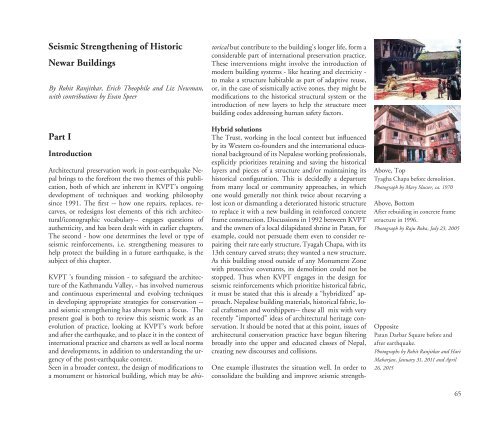KVPT’s Patan Darbar Earthquake Response Campaign - Work to Date - September 2016
Create successful ePaper yourself
Turn your PDF publications into a flip-book with our unique Google optimized e-Paper software.
Seismic Strengthening of His<strong>to</strong>ric<br />
Newar Buildings<br />
By Rohit Ranjitkar, Erich Theophile and Liz Newman,<br />
with contributions by Evan Speer<br />
Part I<br />
Introduction<br />
Architectural preservation work in post-earthquake Nepal<br />
brings <strong>to</strong> the forefront the two themes of this publication,<br />
both of which are inherent in <strong>KVPT’s</strong> ongoing<br />
development of techniques and working philosophy<br />
since 1991. The first -- how one repairs, replaces, recarves,<br />
or redesigns lost elements of this rich architectural/iconographic<br />
vocabulary-- engages questions of<br />
authenticity, and has been dealt with in earlier chapters.<br />
The second - how one determines the level or type of<br />
seismic reinforcements, i.e. strengthening measures <strong>to</strong><br />
help protect the building in a future earthquake, is the<br />
subject of this chapter.<br />
KVPT 's founding mission - <strong>to</strong> safeguard the architecture<br />
of the Kathmandu Valley, - has involved numerous<br />
and continuous experimental and evolving techniques<br />
in developing appropriate strategies for conservation --<br />
and seismic strengthening has always been a focus. The<br />
present goal is both <strong>to</strong> review this seismic work as an<br />
evolution of practice, looking at <strong>KVPT’s</strong> work before<br />
and after the earthquake, and <strong>to</strong> place it in the context of<br />
international practice and charters as well as local norms<br />
and developments, in addition <strong>to</strong> understanding the urgency<br />
of the post-earthquake context.<br />
Seen in a broader context, the design of modifications <strong>to</strong><br />
a monument or his<strong>to</strong>rical building, which may be ahis<strong>to</strong>rical<br />
but contribute <strong>to</strong> the building’s longer life, form a<br />
considerable part of international preservation practice.<br />
These interventions might involve the introduction of<br />
modern building systems - like heating and electricity -<br />
<strong>to</strong> make a structure habitable as part of adaptive reuse,<br />
or, in the case of seismically active zones, they might be<br />
modifications <strong>to</strong> the his<strong>to</strong>rical structural system or the<br />
introduction of new layers <strong>to</strong> help the structure meet<br />
building codes addressing human safety fac<strong>to</strong>rs.<br />
Hybrid solutions<br />
The Trust, working in the local context but influenced<br />
by its Western co-founders and the international educational<br />
background of its Nepalese working professionals,<br />
explicitly prioritizes retaining and saving the his<strong>to</strong>rical<br />
layers and pieces of a structure and/or maintaining its<br />
his<strong>to</strong>rical configuration. This is decidedly a departure<br />
from many local or community approaches, in which<br />
one would generally not think twice about recarving a<br />
lost icon or dismantling a deteriorated his<strong>to</strong>ric structure<br />
<strong>to</strong> replace it with a new building in reinforced concrete<br />
frame construction. Discussions in 1992 between KVPT<br />
and the owners of a local dilapidated shrine in <strong>Patan</strong>, for<br />
example, could not persuade them even <strong>to</strong> consider repairing<br />
their rare early structure, Tyagah Chapa, with its<br />
13th century carved struts; they wanted a new structure.<br />
As this building s<strong>to</strong>od outside of any Monument Zone<br />
with protective covenants, its demolition could not be<br />
s<strong>to</strong>pped. Thus when KVPT engages in the design for<br />
seismic reinforcements which prioritize his<strong>to</strong>rical fabric,<br />
it must be stated that this is already a “hybridized” approach.<br />
Nepalese building materials, his<strong>to</strong>rical fabric, local<br />
craftsmen and worshippers-- these all mix with very<br />
recently “imported” ideas of architectural heritage conservation.<br />
It should be noted that at this point, issues of<br />
architectural conservation practice have begun filtering<br />
broadly in<strong>to</strong> the upper and educated classes of Nepal,<br />
creating new discourses and collisions.<br />
One example illustrates the situation well. In order <strong>to</strong><br />
consolidate the building and improve seismic strength-<br />
Above, Top<br />
Tyagha Chapa before demolition.<br />
Pho<strong>to</strong>graph by Mary Slusser, ca. 1970<br />
Above, Bot<strong>to</strong>m<br />
After rebuiding in concrete frame<br />
structure in 1996.<br />
Pho<strong>to</strong>graph by Raju Roka, July 23, 2005<br />
Opposite<br />
<strong>Patan</strong> <strong>Darbar</strong> Square before and<br />
after earthquake.<br />
Pho<strong>to</strong>graphs by Rohit Ranjitkar and Hari<br />
Maharjan, January 31, 2011 and April<br />
26, 2015<br />
65




